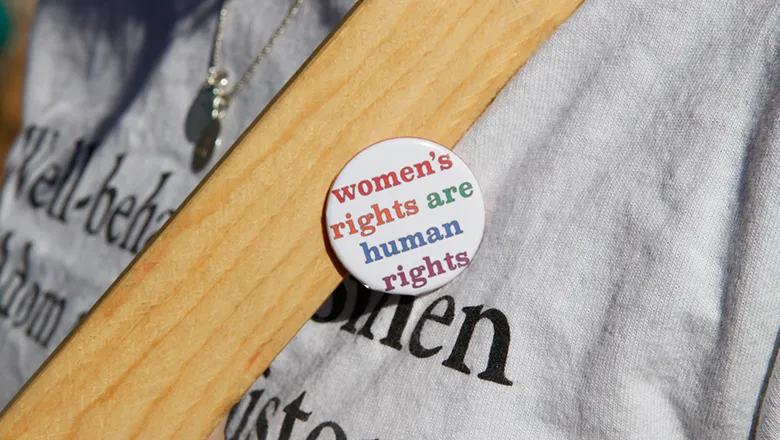15 January 2019
Women's political parties may be marginal in electoral terms, but they still matter
Kimberly Cowell-Meyers, Elizabeth Evans and Ki-young Shin
As outsider organisations operating inside the system, they can recruit women to political activism

‘The tide is high! Replace the racists with feminists!’ As the slogan of the Swedish Feminist Initiative proclaims, the tide of women’s political parties is high once again.
In the last decade, women’s parties have formed in the UK, Norway, Finland, Denmark, Spain, Paraguay, Israel, Lebanon, Turkey, India, Pakistan, Madagascar, South Africa and the Solomon Islands, joining those already functioning in Sweden, the Philippines, Japan, and elsewhere. In fact, over 100 women’s political parties have emerged since 1945, in almost every region of the world.
Most of these parties have been short-lived and marginal but others have achieved electoral success. Many have managed to pressure the mainstream parties to take up women’s issues, so they are worth paying attention to because they have the potential to alter the pattern of women’s representation and improve the quality of democracy.
Though women’s parties share an aim to increase women’s political representation, not all women’s parties are feminist. In fact, surveying the platforms and manifestos of women’s parties reveals three types of parties: depending on the degree of transformation the party seeks, women’s parties can be feminist (challenging patriarchy), proactive (advancing women’s inclusion) or reactive (espousing conservative or traditional roles for women).
Women’s parties can be found on both the left and right of the political spectrum although most women’s parties lean left. Others explicitly reject the constraints of left-right politics and either avoid taking stances on issues that might divide their membership (e.g., the UK Women’s Equality Party initially chose not to take a position on Brexit) or frame their essence around a ‘third dimension’, based on gender as the primary consideration.
The first recorded women’s parties arose in the early 20th century. They emerged with greatest frequency in the 1990s alongside the reconfiguration of political systems in Central and Eastern Europe. The first decade of the 21st century produced more than 20 and this decade, as the above list indicates, is likely to as well. They have occurred most frequently in Europe, where at least 50 have emerged; Latin America, where gender quotas for candidates are almost universal, has seen only three, including Paraguay’s current Kuna Pyrenda. Some states such as Poland, India, Israel, and New Zealand have seen multiple women’s parties emerge over time (although usually not in the same elections).
Women’s parties tend to fly below the radar because they don’t meet the threshold for earning seats (usually 4% of the popular vote) but there are exceptions; parties in Iceland and Armenia, for example, earned more than 10% of the vote. The parties are typically short-lived, although the German Feminist Party campaigned in multiple cycles and Gabriela in the Philippines and Netto in Japan have held seats at the national or local level for more than a decade.
Despite being short-lived and electorally marginal, women’s parties are still important. They tend to emerge in places where women perceive that the mainstream political parties neglect women or their issues, usually by not running female candidates or addressing women’s concerns. Because they typically emerge alongside or out of the grassroots politics of the women’s movement, they tend to do politics differently. As outsider organisations operating inside the system, they can recruit women to political activism, disrupt the perception that politics is a male-domain and connect women’s movement organisations to formal politics. And, even those that lack a large following have, in some cases, pressured the larger, more mainstream parties to run more female candidates or pay greater attention to women’s interests in their platforms and policies; because women’s parties have resources that civil society actors lack, they can impact both the descriptive and substantive representation of women and women’s interests. And, as both established and emerging democracies currently face reactionary pressure from populist and far right actors, women’s parties can challenge anti-woman and anti-minority group narratives. Gabriela has played this role in particular in the Filipino legislature as the mouthpiece for resistance to the Duterte regime.
Women’s parties matter. Their emergence reveals a perception that the representation of women, and women’s interests, are not taken seriously by existing political parties. That they are able to mobilise the large number of actors required to build and sustain a political party reflects not only the strength of the women’s movement but also the galvanising effect of women’s representation as a key political issue.
Kimberly Cowell-Meyers, Elizabeth Evans and Ki-young Shin are guest editors of a forthcoming special issue of Politics and Gender that explores women’s political parties and authors of ‘Women’s Political Parties: A New Party Family’ (under review).
Kimberly Cowell-Meyers is an Assistant Professor in the School of Public Affairs at American University; Elizabeth Evans is a Senior Lecturer in Politics at Goldsmiths, University of London; and Ki-young Shin is an Associate Professor of Political Science and Gender Studies in the Graduate School of Humanities and Sciences and the Institute for Gender Studies at Ochanomizu University Japan.
